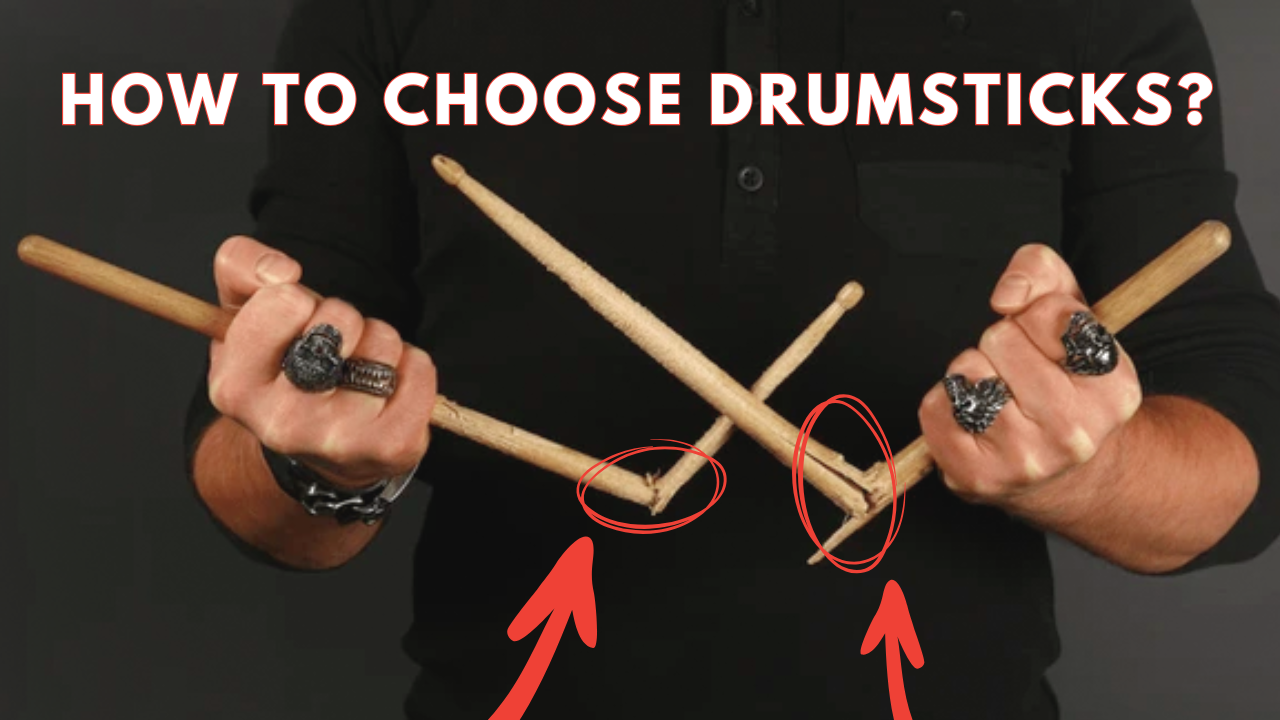The material of your drumsticks significantly impacts your playing experience and how you produce sounds when striking drums and cymbals. As key percussion instruments, drumsticks can be produced from wood, carbon fiber, and hybrid materials, each having specific properties and offering unique sound quality. For those who feel overwhelmed by the choice and don’t know where to start, we have prepared this guide on choosing drumstick materials with a comparison of different options.

How The Material of Drumsticks Affects Your Drumming
First of all, the hardness of the sticks impacts how long your instruments will last. Synthetic drumsticks are typically seen as the most practical options for outdoor performances as they are more resistant to environmental factors such as humidity or temperature extremes.
The material affects the weight of the sticks and their use in specific musical settings. For instance, maple drumsticks are more suitable for fast-tempo playing as the material feels light in hands. These sticks allow drummers to play without fatigue during extended sessions. On the other hand, heavier options, such as oak or hickory drumsticks, may feel heavier; however, they function better in more powerful genres, where high-volume is required.
The material of the sticks also shapes the sound. Harder materials lead to brighter and articulate sounds with defined attacks, while drumsticks made of softer options offer warmer tones.
The material of drumsticks also plays a significant role for your personal comfort. Natural woods offer a traditional feel, however they may not be perfectly straight, featuring curves, which will affect your feel when drumming. Synthetic drumsticks can provide a more comfortable grip.
Wood Drumsticks
Wood still holds a reputation as the most popular material for drumsticks. The key advantages of wood drumsticks are:
- the unique sensations,
- their unique ability to absorb vibrations,
- their flexibility.
On the market, you can find drumsticks made of various wood types, each is possible to work better than others depending on personal drummers’ preferences.
- Hickory with excellent balance of resistance to breaking and shock absorption, used across various genres. It’s the best choice for those who don’t want to take a huge stick arsenal, as they let musicians use them for different tracks without switching to other options.
- Maple, favoured by jazz drummers and those who play in lighter music styles for their lightweight construction and comfortable feel during faster playing. They feel easy on the wrist and offer a more delicate touch, however they may not be the best options for beginners, as they offer less feedback.
- Oak, serving an excellent material for high-volume genres and featuring enhanced durability. It’s perfect for drummers seeking a lot of feedback and louder hits without putting much effort. However, keep in mind that they don’t absorb much of the vibrations, which may lead to wrist ache and damage to cymbals over time.
- Laminated Birch, featuring a balance of weight and durability, which is popular among drummers in various genres.
- Exotic Woods, such as ebony, rosewood, and walnut, offering unique sound characteristics at a higher price, compared to the rest of options.

Carbon Fiber Drumsticks
Carbon fiber drumsticks are especially valued for their durability and comfort. Produced from renewable resources and fully recyclable, these sticks are also favoured by drummers who prefer environmentally-friendly products.
Carbon fiber sticks offer the following advantages:
- Perfect ergonomics and lightweight construction. These sticks feel like the extension of the drummer’s hands.
- Strength. These sticks are more resistant to breakage than wood.
- Reduced risk of wrist damage. Some models of these sticks feature a long rubber tip that dissipates vibrations, preventing them from transferring to your arms.
- Comfortable grip and reduced strain. A smooth surface allows them to feel comfortable in musicians' hands, even during extended playing sessions, rehearsals, and concerts.
- Darker sound. Compared to wood drumsticks, these offer a darker sound.

Hybrid Drumsticks
These sticks combine features of different types and offer a unique balance of feel, sound, and long lifespan. They are favoured by drummers who want the same control as provided by standard sticks and the power of marching sticks, all in one.
Hybrid drumsticks and available in several options:
- Sticks with a wood shaft and nylon tips. These can serve longer while offering brighter cymbal sound.
- You can also find drumsticks with heavier stick bodies and a shorter taper or modified tip, and even sticks with metal or nylon brushes on one end and wooden tip on the other.
How To Extend Life of Your Drumsticks
Your drumsticks serve longer if you don’t drop them and if you have chosen them correctly for your genre. Sticks aimed at lighter music styles won’t last long if you beat the hell out of them.
To help your drumsticks, especially those made of wood, serve longer, it’s important to responsibly consider how you store and transport them. Wood is very sensitive to temperature changes and humidity, so it needs secure protection.
To reduce the impact of environmental factors and prevent sticks from damage, you can use specially designed large drumstick bags or compact drumstick bags, depending on the quantity of sticks you need for your performance. They are especially useful if made from waterproof leather, which serves as a reliable barrier under various conditions.
If your working arsenal is reduced to only a pair of sticks, you can opt for compact and lightweight drumstick pouches. They can feature magnetic or button stud closure, offering your sticks a secure hold without any risk of accidental opening.
Conclusion
There are plenty of options when it comes to materials of drumsticks: wood, carbon fiber, and hybrid materials. When selecting drumsticks, consider the sound characteristics you want to achieve, genre and playing style you most frequently work in. You can find what works best in terms of tonal quality, control, and feel for you only through experimentation with different types.
Are you searching for specific cymbals or cymbal sets? We invite you to explore a wide range of products in our collection of High-Quality Accessories for Drummers.
Recently we’ve also shared The Ultimate Care Guide and Tips on cleaning your cymbals. Check them out!



 https://kgumusic.com/pages/about-us
https://kgumusic.com/pages/about-us